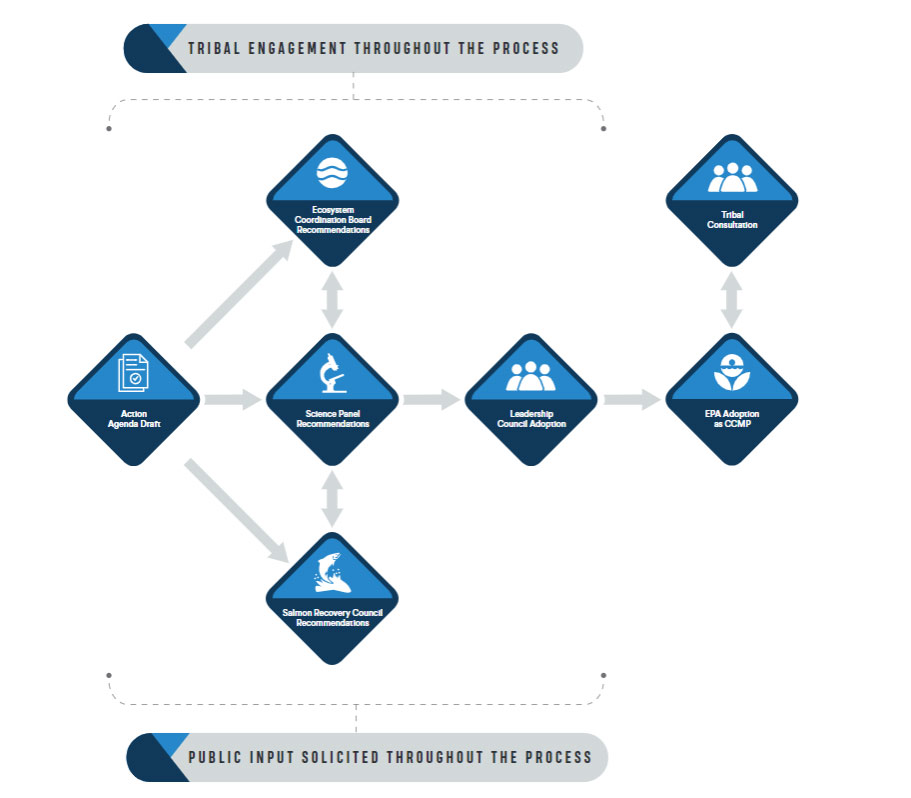ACTION AGENDA BACKGROUND
In 2007, in response to the imperiled status of Puget Sound, the Washington State Legislature created the Puget Sound Partnership to coordinate and lead the effort to recover Puget Sound through a strategic, prioritized, science-based Action Agenda “that addresses all of the complex connections among the land, water, web of species, and human needs.” (RCW 90.71.200). The Action Agenda also fulfills the Partnership’s statutory mandate and purpose of the Clean Water Act’s National Estuary Program (NEP).
The Partnership updates each Action Agenda through an adaptive management approach. The updated 2022-2026 Action Agenda has a strategic approach to recovery that:
- Leverages and amplifies the work of ongoing programs
- Promotes multi-benefit outcomes that influence multiple Vital Signs
- Integrates biophysical strategies with climate change and human wellbeing
- Includes new Vital Sign targets to improve monitoring and accountability of recovery efforts
Partners in recovery
Ecosystem recovery is only possible with the foundational work and partnership of many organizations and champions committed to long-term protection of Puget Sound. Government agencies, tribal nations, private-sector institutions, academia, nongovernmental organizations, community-based organizations, and members of the broader public have each led and stewarded the care of Puget Sound. The Partnership engages with the work of this broad set of partners, encouraging participation, and aiming to reflect the diversity of our region’s growing, multicultural population.
The Partnership boards and entities formally associated with development of the Action Agenda are depicted in the following table.
Puget Sound Partnership |
Supporting Organizations and Work Groups |
Government Partners |
|
|
|
How is the Action Agenda developed?
The Partnership provides leadership through the collective development of updating the Action Agenda, progress measurements, and funding strategy.

The Partnership’s three statutory boards direct the Partnership in its charge of accelerating the science-informed effort to recover Puget Sound. Two advisory councils advise the Leadership Council on matters related to Puget Sound recovery. These boards and advisory councils are key to the Partnership’s role and coordinate their priorities for maximum effectiveness via shared goals.
Community members and residents can also support the recovery effort through their own actions. For example, by voting for programs and candidates that support the stewardship of the Puget Sound and by considering sustainability and the environment in their purchasing decisions.
How is Puget Sound recovery defined?
To guide the recovery effort, the Action Agenda describes what a healthy Puget Sound would look like. This definition is grounded in a set of goals from the Washington Legislature and the community’s vision for a resilient ecosystem.
Healthy human population |
Healthy people are supported by a healthy Puget Sound. |
Vibrant Human quality of life |
Our quality of life is sustained by a healthy Puget Sound. |
Thriving species and food web |
Puget Sound species and the web of life thrive. |
Functioning habitat |
Puget Sound habitat is protected and restored. |
Healthy water quality |
Puget Sound rivers and streams have sufficient quality and flow to support people, fish, and wildlife. |
The Puget Sound Vital Signs and their indicators are measures of ecosystem health that describe our vision for the future. Vital Signs also articulate the statutory goals for Puget Sound recovery and describe how we will know whether statutory goals are achieved. The 2022-2026 Action Agenda sets targets for six Vital Sign indicators. These targets represent iconic and valued components of the Puget Sound ecosystem, and they are strongly linked to the work proposed in this Action Agenda.

Funding recovery
The Partnership works closely with partners to develop a dependable and diverse funding strategy that will support Puget Sound recovery now and in the future. Federal, state, local, and tribal governments currently provide much of the funding for Puget Sound recovery actions. Non-governmental agencies, private foundations, businesses, and individuals also provide funding.
Puget Sound funding strategy
An effective funding strategy for Puget Sound recovery aims to:
- define the full range of funding needs for Puget Sound recovery;
- maintain and efficiently use existing funding;
- engage local voices to determine how and where to best spend funding with clarity and impact; and
- secure additional funding to fully implement Action Agenda strategies and actions.
Funding approaches must also integrate principles and practices of honoring tribal nations’ treaty and sovereign rights, equity, and environmental justice to address the harmful effects effects felt by some communities.
The funding strategy for Puget Sound recovery is detailed in the 2022-2026 Action Agenda and includes five key components:
- Establish a clear picture of the size and nature of the funding need for Puget Sound recovery
- Maintain and increase funding from existing Puget Sound recovery sources, including developing a major new source of state funding
- Increase the effectiveness of investment decisions for existing sources of funding
- Build a portfolio of new private funding sources
- Enhance capacity for rapid funding response
Last updated: 06/02/22